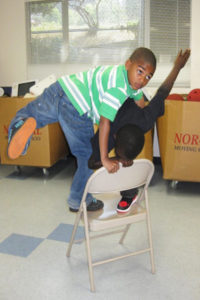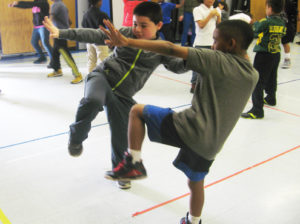What does a dance class for students with and without disabilities look like? Can it build a climate of empathy at a public school? How might it be a vehicle for individual creative freedom?
It’s nine on a Wednesday morning and the East Oakland sun has made its full debut over the hills and surrounding treetops, bathing the Grass Valley Elementary School playground in its warm, golden rays. Two 4th and 5th grade classes make their way to a big room next to the playground, a space with tall ceilings that’s furnished with long, cafeteria folding tables and decorated with posters offering snappy slogans about respect, fairness, trustworthiness, citizenship. The room is aptly named the Multi-Purpose Room: it serves as an indoor gym, a cafeteria, a place for assemblies and performances. This morning it will transform once again, this time into a dance studio, where students and classroom teachers will dance, improvise, co-create, meaning-make and reflect, all with the goal of building empathy and a school culture of inclusion in order to stymie the bullying that has recently cropped up among students.
This kind of dancing happens weekly at Grass Valley Elementary but on Wednesdays there is a catch, a little something different: of the two classes that come together one is a Special Education class for students with disabilities and the other is a General Education class for students who do not have disabilities. My co-teacher and I welcome the students, teachers and paraprofessionals into the space where we make one large circle. We say to the group that we are here to dance altogether, that the purpose of these classes is to dance with people we don’t normally dance with, that later in the class we will ask everyone to partner with someone from a different class. We say that we expect students to be open to dancing with new people, to try their best, to have fun. We begin our warm-up and progress through the class embodying the energy concepts smooth and sharp. The air in the room comes alive as students, many of whom are new to dance, fly through the air with sharp, jagged jumps before they melt to the floor in smooth slides that blaze long, narrow pathways, traversing nearly the entire space. We are in awe of the full-throttle dancing happening before us. We see no differentiation of ability/disability in this moment; all students are fully embodied, engaged in designing their own choreographic reality.
Now it’s the time in the lesson when we ask students to find a partner from a different class. This doesn’t happen quickly or easily. Students are reluctant to leave their friends, their classmates, to pair with someone they don’t know. And, there is stigma: students in the Special Education class know they are second-class citizens in the eyes of their General Education peers. They know it from the names they are called and they know it from the games they’re excluded from. The bold, embodied confidence that existed just a moment ago gives way to stillness and hesitation. We request help from their teachers to encourage and partner students who are hanging back or unsure.
Once in pairs, students face each other and follow movement prompts such as: do sharp aerial movements toward your partner, meet them in the middle and freeze in a sharp shape; do different sharp aerial movements away from your partner; or try gliding smoothly toward your partner, freeze in a smooth shape, do a smooth dance away from your partner. We repeat prompts like this, modifying them with different locomotors, levels, and energy elements, all the while naming aloud the movement choices we see students making and using these to inform our next prompt.

Students go on to compose dances that examine the toward-and-away relationship of duet-ing with another person. Some students struggle: it’s a lot to creatively engage with someone you don’t know who has abilities different than your own. When we reflect at the end of class, students reveal that the experience was fun, challenging, illuminating. As the classes line up to leave, a 5th grade student comments to his teacher about his experience of working with someone new, “We’ve never danced together before. We could be friends.”
At Luna Dance Institute, we are in the second year of the Dance Inclusion Class pilot project at Grass Valley Elementary. The work has been exhilarating and a challenge. As a teaching artist and choreographer, I observed many moments of creative, choreographic discovery in classes I taught, from Kindergarten all the way through fifth grade. I noted that as a session went on, the iciness between students from different classes began to melt and finding a partner happened more quickly and required less teacher intervention. It was clear that students engaged in more artistic risk-taking in their compositions, including sophisticated movement invention and partnering that we had not investigated in class but was borne of kinesthetic experimentation. Students became more articulate in their reflections of their choreographic process and classroom teachers began to witness their students in new and different ways.
A teacher of 4th and 5th grade students with moderate to severe special needs watched in awe as one of her students incorporated poly-rhythmic articulations of his arms, shoulders and spine while he danced. After class she revealed to me that, although they were already half-way through the school year, nobody knew he could dance like that or that he possessed such innate talent. Another teacher, of second grade students in a General Education class, commented to us after class, “I have really hard behavioral challenges in my class and they [the students] are already successful.” It was the first day of class.
Other positive outcomes of the project include a shift in school culture; at an end-of-year focus group classroom, teachers noted that students from the Special Education and General Education classrooms were interacting more during unstructured times such as recess and lunch. They also reported that within the classroom community, students were partnering and forging friendships with their peers whom they had previously shied away from.
And, still, a pilot project is just that: a testing of the waters, a creative risk in itself to see how organizational and programmatic structures working in concert can effect positive change. There is beauty, and there is the blunt edge of challenge, a call to use the embodied knowledge that comes from being a dance artist in order to assess and reconfigure, in order to find another way.
One of these challenges was the clear discrepancy in student ratios; Grass Valley Elementary has classrooms for students in Special Education for all grades, starting in Kindergarten and going all the way through 5th grade, however, the number of children in each class is significantly lower than the classes of students in General Education. This meant that several classes of students with special needs did two or more sessions of Dance Inclusion Classes. They deepened their dance learning but they also had to accommodate more than their General Education peers. Already carrying the stigma of Special Education, the onus fell on them to be the most open and flexible when it came time to dance with students from another class.

In addition to this continual shape-shifting, the imbalance in student numbers also affected the curriculum we built. Although we envisioned most of the collaboration as a 1:1 duet relationship, instead, the students often had to form trios. This burst open our box of what we thought it meant to relate spatially, in time, with energy to a single partner and helped us rethink the curriculum in order to design it more creatively. Through this process, we also found that we developed more agency with the classroom teachers we worked with.
Grass Valley Elementary is a unique school – for 7 years they have partnered with Luna Dance Institute to build a school-wide culture of dance with full scope and sequence arts education to as many students as possible and using dance as a means to meet their Social-Emotional Learning (S.E.L) goals. Many of the teachers there are veteran educators and have worked in the Oakland Unified School District for the majority of their careers. They are a united and deeply committed community of teachers working to offer their students every opportunity for extended learning (dance, music, visual art, Maker Space, gardening, library time) while having to meet test score and learning standard benchmarks and working in a district that is, once again, in a severe budget crises, resulting in deep cuts to the schools themselves.
But, challenging times call for relentless creativity. And, so, this marks the second year of our Dance Inclusion Class pilot project. As of this publishing, the project will have been featured at two conferences, written about in a dance education magazine and represented at a panel discussion. We retooled some details in order to create as much time and space as possible for students to discover their own dancing selves while developing empathy for their peers who experience the world in a different way than they do. The initial disequilibrium of relating to something and someone new continues to happen in the first few classes at every grade level, in every session. But, the joy of finding the freedom in one’s own physicality, and sharing that joy with a newly-found collaborator, is beyond limit.
This article appeared in the March 2018 edition of In Dance.

